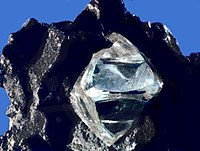
Photo from wikipedia
Metal-organic frameworks (MOFs), as a new class of proton conductors, have attracted much attention in the application of proton exchange membranes due to their precisely defined structure and tailorable functionality.… Click to show full abstract
Metal-organic frameworks (MOFs), as a new class of proton conductors, have attracted much attention in the application of proton exchange membranes due to their precisely defined structure and tailorable functionality. However, for most of the MOF materials, their long-term stability is a huge barrier to practical application. Therefore, the structural stability of MOFs is an important prerequisite for the design and development of proton conductors with ultra-high conductivity. In this study, the stable UiO-66-NH2 is optimized as the precursor, and the modified material of DT-UiO-66 is designed and developed by introducing the 3,5-diamino-1,2,4-triazole molecule into the framework of UiO-66-NH2 through a post-synthesis strategy. Satisfactorily, DT-UiO-66 maintains the stability of the original skeleton. The alternating current impedance measurements indicate that a significantly improved proton conductivity of 4.47 × 10-3 S cm-1 is obtained at 100% relative humidity (RH) and 373 K for DT-UiO-66, which is attributed to the increasing number of proton sources and hopping sites. Moreover, DT-UIO-66 shows an outstanding stability under high temperature and high humidity conditions for at least 16 h, suggesting its potential application as a proton exchange membrane.
Journal Title: Dalton transactions
Year Published: 2021
Link to full text (if available)
Share on Social Media: Sign Up to like & get
recommendations!